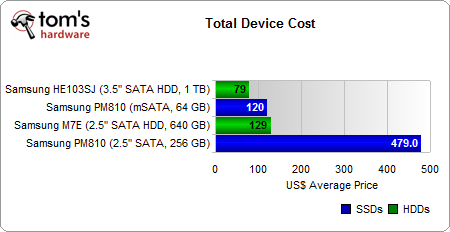Hands-On: A Second mSATA-Based SSD Emerges
When it comes to storage, the 3.5” and 2.5” form factors are most popular. But they're not always suitable for notebooks and netbooks. Samsung is the second vendor to introduce an mSATA-based SSD, after Intel demonstrated its SSD 310 earlier this year.
Summary: Cost, Cost/GB, And Performance
We gathered street prices for all devices. Some of the latest high-end SSDs with 6 Gb/s SATA interfaces easily cost more than the $479 we paid for Samsung’s 470-series (256 GB). All price points refer to the test drives we used, but they can be seen as rough estimates for their market segments.
Once we relate cost to capacity, things don’t look as good for SSDs any more. Cost per gigabyte is about 20 times higher on solid-state devices. Interestingly, this roughly equals the spread between SSDs and hard drives when it comes to I/O performance.
However, if we leave offerings like the 256 GB drive out of the equation, the total price range of $100 to $150 for mainstream SSDs is acceptable for enthusiasts. The problem then becomes one of capacity, since you're still paying the same cost per gig. Sixty-four gigabytes might not be enough for most folks. Really, you'd have to be comfortable with an operating system and a couple of apps on the SSD, using a conventional disk for everything else. This is going to be seen as an insurmountable limitation by many.
Finally there is our performance index for the SSDs, which consists of throughput, PCMark Vantage scores, and I/O performance. Effectively, all we're showing here is that the technically-handicapped mSATA design does not suffer too much from its halved number of flash memory channels.
Get Tom's Hardware's best news and in-depth reviews, straight to your inbox.
Current page: Summary: Cost, Cost/GB, And Performance
Prev Page Benchmark Results: Power Requirements Next Page Conclusion

